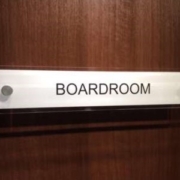OP-ED: Navigating Employment with a Disability
October is Disabilities Awareness Month
According to the most recent data from the U.S. Bureau of Labor Statistics, the unemployment rate for persons with a disability is 81.3% that means only a 18.7% employment rate. Among persons with disabilities ages 16-64, the unemployment-population ratio is 70.7% (29.3% employment-population ratio)
These numbers prove we have inclusivity problems in areas beyond the media & government websites. By “we” I mean people with disabilities. I am a wheelchair user and part of the disabled minority that has a higher-education degree. I am part of the 32% of working disabled persons who work part time and the 10.6% of working disabled persons who are currently self-employed.
At the time I’m writing this post, I’m simultaneously trying to boost my freelance salary to a full-time equivalent and/or find full-time employment. I wish I could claim to be an “expert” on helping people with disabilities find employment; I’m not. I’m a freelance writer who knows what the climb toward (and fall away) from full-time employment feels like.
I’m always learning on my journey. One thing I know is that if you’re looking for a job, it’s important to know your rights as a disabled person under the Americans with Disabilities Act (ADA,) the U.S. Equal Opportunity Employment Commission (EEOC,) the Department of Justice (DOJ,) the Department of Labor (DOL) and state and local government. All of the aforementioned departments are responsible for upholding the rights provided to you by the ADA.
I’ve also acquired a wealth of tips that have made job searching with a disability less overwhelming. Hopefully, this post will make your climb a little bit easier.
Know Your Employment Rights & What They Mean
After July 26, 1994, the ADA protected persons with disabilities from job discrimination by “all employers, including State and local government employers, with 15 or more employees.”
That sounds simple enough, but as with most laws, you won’t clearly understand your rights until you know the definitions of key terms and know where the loopholes are.
To be covered by the ADA, you must have all of the academic qualifications and work experience required by the employer to do the job. Your disability must be a “substantial” impairment, meaning that it affects a major life activity like seeing, hearing, speaking, walking, breathing, self-care, completing manual tasks, learning, and other functions. You must be able to perform the essential roles of the job with or without reasonable accommodations.
“Reasonable accommodation” can be defined as a modification or change to the job or environment that helps a disabled person perform essential tasks or receive equal benefits to other employees. This includes the application process.
Some examples of modifications include providing readers or interpreters, adjusting work schedules, modifying training or tests and more. Your employer is required to provide you with reasonable accommodations unless they can prove that doing so would cause “undue hardship.” Undue hardship is substantial difficulty or financial distress.
Employment practices that the ADA covers includes:
- Recruitment
- Hiring
- Training
- Firing
- Pay
- Promotion
- Benefits
- Leave
- Lay off
During the hiring process, your employer cannot ask you if you are disabled or about the severity of your disability. They can ask you questions about completing job-related tasks with or without accommodation, including asking you to demonstrate how you would perform a task.
You cannot be required to take a medical exam before being offered a job. After a job offer, an employer can ask that you complete a medical exam if they require one of all employees. You cannot be discriminated against based on any information that comes from the exam. When you begin working, your employer can only ask questions about your disability if they relate to the job. All of your medical information is to be kept confidential.
Your employer is not required to offer a health care package that includes pre-existing conditions. The ADA does not require that a person with a disability be hired over other qualified applicants because they have a disability.
An employer can refuse to hire a candidate if they pose a threat to themselves or others. The threat must be an objective fact based on evidence. The employer cannot refuse to hire you because of a “slightly increased risk” or perceived risk to you or others.
Building Codes & the ADA
All of the employment protection in the world won’t help you if a building’s structure is inherently inaccessible. The ADA has compliance guidelines for contractors so there is an accessibility standard when building businesses. There are a lot of technical points regarding space needed for wheelchairs and it’s very technically worded and impossible to memorize. Unfortunately, there are loopholes and exceptions written in, as with most laws. But, it’s good to understand some basic rules and note if they aren’t followed upon your first visit to the building.
Tips for the Job Search & Beyond
The hard truth is that the ADA is not your biggest advocate, you have to be. It takes us more work to land the interview, and we can’t relax when we’re in the room if we want to get the job. Here are some tips I’ve learned to help you make job searching less stressful than it already is.
Tip 1: Use Your Resources
If you have resources available to help you find a job at the level your qualification/experience allows, use them. Able-bodied people do it all the time.
Networking with a disability can be difficult, especially in person. I find that as a wheelchair user, I’m constantly fighting to be heard. A group of people (OK, honestly even one person) is not likely to kneel down on my level, so I have to look up constantly and be loud often.
It shakes my confidence, especially in professional situations. Disabled people know that the ADA only protects us so much. Do what you need to do to level the playing field as much as possible. Here are some ideas:
- Vocational services
- Resume writing services
- Headhunting services
The statistics above prove that even with the ADA in place, having a disability makes it more difficult to get a job. Don’t be ashamed to reach out wherever you can for help.
Always speak up for yourself. Make sure the jobs you are seeking are not below your intellectual abilities.
Tip 2: Know the Building
If, when and to whom you disclose your disability is entirely your decision. If you choose not to disclose, you still need to be sure the building meets your needs before an in-person meeting.
Have a friend or family member call to ask if the building is accessible. That term is general and means different things for everyone, so future accommodations might be necessary. (See above for some basics.) But any barrier that keeps you from having a successful interview or first day should be addressed as soon as possible.
If you are a wheelchair user and there is a huge staircase in front of the building, for example, you need to know of alternative entrances. Having a friend call is a way to maintain your right of non-disclosure for as long as you can. They don’t have to identify themselves or ask anything beyond basics.
Look at the bathroom before the interview if you can. If the bathroom doesn’t meet your needs or is being used for storage, address the issue carefully. Do not view the facilities with your employer.
If you feel like your rights are being violated, record it. Digital records are more reliable than paper these days as it’s more difficult to misplace them.
If you don’t feel comfortable asking a superior to record agreements or conversations for you, do it yourself. If your rights are being violated, you’ll need to prove it in court, and that’s not easy. The more records you have, the better your case will be. Contact a lawyer or call the EEOC for more information.
Guest Contributed by Sarah Turner
Sarah is an experienced content writer and digital marketer. She is a well-versed online strategist and produces quality content to help others improve their website. Her expertise covers site development, social media promotion, SEO and content creation.











